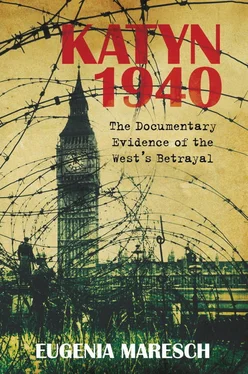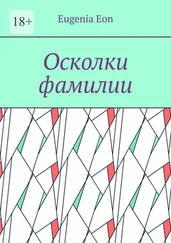In private, avoiding politics, I brought up the news of the recent successes of the Russian Army. The German officer admitted their prowess, but claimed that the war wouldl end in the summer of 1943, following a decisive success in the East and later a victory over England.
The following day, 16 April, we arrived at our destination at nine in the morning. The Koze Gory woods are situated a few metres away from the road. In a clearing, amongst the graves, the corpses of the exhumed officers lay stretched out. Above them flew a large Red Cross flag. There was no doubt that we were dealing with a mass execution carried out by expert hands. All the corpses I saw had bullet entry holes at the nape of the neck and exit holes in the forehead. The uniformity of wounds by firearms and the course of the shots indicated that they were done with pistols at close range, fired at the victims in a standing position. Some corpses had their hands tied with a rope; presumably those who struggled in self-defence. The Polish uniforms, decorations, rare insignia, regimental badges, coats and boots were in good condition, in spite of contact with the earth and decomposition. Deep inside the graves, there were other layers of corpses showing parts of legs, arms and trunks sticking out of the sand. Of note was the proportion of senior officers, Majors, and Lt-Colonels. I inspected the corpses of two Generals identified as [Mieczysław Makary] Smorawiński and [Bronisław] Bohatyrewicz; their General’s insignia and stripes on their trousers indicated their rank.
Amongst the older pine trees, grew younger ones, in my opinion self-propagated, which would indicate that the execution must have taken place in the spring of 1940. It was alleged that a competent forester recognised the same age of the pines based on root identifications. I did not see any of the pine trees over the graves, as the graves were already opened. As to the number of the dead in all the graves, I had a feeling that the number declared by the Germans to be 10 to 12, 000, was largely overestimated. After a short prayer and blessings said by Canon Jasiński, we left by car for the office, some 6 kilometres away. Just before departing I categorically refused three times to speak in front of the microphone.
Inside the house there was an office for sorting and looking through the documents; the more interesting ones were displayed in glass cabinets. We studied some of the documents and diaries, all of which ended with early dates of April 1940. After a courtesy meeting with Dr [Gerhard] Buhtz, a criminologist from Wrocław (Breslau), University, we departed for Smolensk. At the last moment, I was asked again to say something into the microphone and I refused. However, asked to say a few words privately about my feelings, I replied that I am departing with a heavy heart, deeply moved by what I had seen. I took this opportunity to acknowledge the hard and methodical work at the site of the graves undertaken by the army.
In Smolensk, it was again agreed with OLt Slovenzik to leave behind Rojkiewicz, Wodzinowski and Kołodziejski, and that after two or three days, Rojkiewicz would return to Warsaw with a better action plan for the work of the Commission. In the meantime, it was hoped that some understanding would prevail between the German authorities in Kraków and the PCK Executive Committee, that a new head of the Commission would be despatched forthwith. The rest of the PCK team departed directly for Warsaw with me on 17 April.
On the morning of 18 April, I presented a verbal report to the Executive Committee. It was incorporated into the minutes of the No. 332 meeting, which stated that:
1. In a place called Katyn near Smolensk, there are partially dug up mass graves of Polish officers.
2. Based on a visual inspection of some 300 dug up corpses it can be stated that the officers were murdered by shots to the back of the head, furthermore, the same type of wounds undoubtedly indicated a mass execution.
3. Plunder was not the reason for the massacre, as the bodies were in full uniforms with boots and decorations and besides, a significant amount of paper money and coins was found.
4. According to documents found on the corpses, the murders took place in the months of March–April 1940.
5. To date, only a small number of names had been established (about 150).
6. To identify and register all the dead men, it is necessary to increase the present team in Smolensk by five to six persons.
7. The work of our Technical Commission can only be developed and moved forward with the co-operation of the competent German Army unit in the area.
8. Our committee on the ground has met with an exceedingly courteous manner and total co-operation from the German Army authorities.
The first six points do not require explanation. Regarding point 7: in the undertaking of exhumation work on this scale, outside Poland in a foreign country devastated by war and occupied by our enemy, and additionally on the front (Smolensk was only 30 to 40 kilometres away from it), the PCK could only contemplate the work with the assistance of the German Army. Otherwise the problem could not be overcome technically or financially. It must be remembered that in the case of Katyn, or in any other matter, the aim of German politics and that of the PCK were completely divergent. The aims of the PCK were to exhume and identify the bodies and re-bury them in new graves as quickly as possible. The Germans however, were concerned entirely with propaganda. This divergence of aims led to frictions, of which I shall write later.
It was unrealistic to think that German propaganda would let go of its control, just to make a good impression on the Polish public, though there was an element of this, albeit of a secondary nature. The PCK had a choice, either to resign from further work, or to agree to a lesser role operating under the supervision of the German Army. Taking account of the above the PCK chose the second alternative.
Regarding point 8. By leaving behind a small Technical Commission in Smolensk, which was totally dependent on the Germans and having in mind its honourable aim, the PCK Executive Committee considered it appropriate to agree to the motion. Thus a good start was ensured.
At the same meeting, the Executive Committee decided to announce that on the basis of my report, it was ready to start work in Katyn, pending written consent from the German authorities. It came as a verbal declaration from a delegate of the Generalgouvernment at a meeting in Kraków on 22 April.
That same day, 18 April, I was summoned to the Bruhl Palace, where in the presence of Dr Grundmann, Dr Heinrich and two other Gestapo officers, I was asked to give a report of our visit to Katyn. During our conversation I had been asked to give interviews to the press, which I declined. They then demanded from me a written report of what I had seen, so that it could be published in the press, allegedly for the benefit of Poles living overseas in England and America. Again, I declined to write such a statement, indicating that to my mind it would not be effective, as exiled Poles would know that I had a choice of either signing the report or being sent to a concentration camp. Dr Grundmann, laughing, agreed with me. Then, Dr Heinrich in his role of overseeing the PCK angrily demanded a written official report by 5 o’clock in the afternoon. As a result, the PCK Executive Committee sent him a resumé of extracts of my minutes.
About noon the same day, in the Warsaw office of one of the bank managers, I gave a clandestine verbal account of my journey before the AK [Home Army] Civilian Warfare Commissioner, who acted as the Delegate of the Polish Government [in exile].
Читать дальше












